Name Erich Priebke Unit Gestapo Allegiance Nazi Germany | Service/branch Schutzstaffel Rank Hauptsturmfuhrer | |
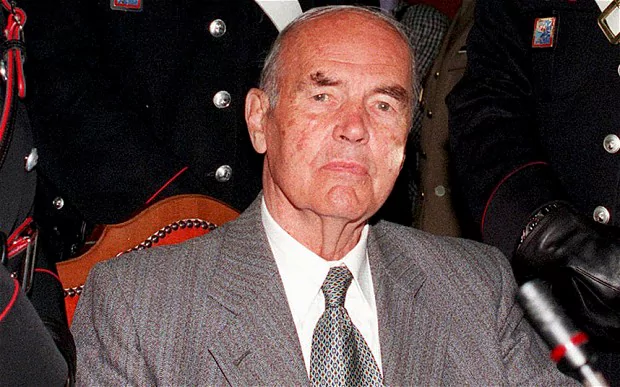 | ||
Born 29 July 1913Hennigsdorf, Prussia, German Empire ( 1913-07-29 ) Died October 11, 2013, Rome, Italy Similar Herbert Kappler, Karl Hass, Alois Hudal | ||
Erich Priebke
Erich Priebke (29 July 1913 – 11 October 2013) was a German mid-level SS commander in the SS police force (SiPo) of Nazi Germany. In 1996 he was convicted of war crimes in Italy, for participating in the Ardeatine massacre in Rome on 24 March 1944. 335 Italian civilians (among them 75 Italians of Jewish ancestry) were killed in retaliation for a partisan attack that killed 33 men of the German SS Police Regiment Bozen. Priebke was one of the men held responsible for this mass execution. After the defeat of Nazi Germany, he received help from a bishop stationed in Rome and fled to Argentina on a Vatican passport, where he lived for over 50 years.
Contents
- Erich Priebke
- Italy rome erich priebke former nazi official is to stand trial
- Early life
- Fosse Ardeatine massacre
- Postwar escape
- Extradition of Priebke
- Priebke in court
- Appeal
- Priebkes appeals
- Death
- References
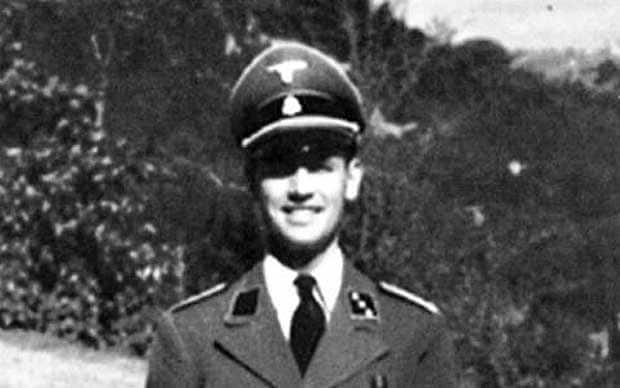
In 1991, Priebke's participation in the Rome massacre was denounced in Esteban Buch's book. In 1994, 50 years after the massacre, Priebke felt he could now talk about the incident and was interviewed by American ABC news reporter Sam Donaldson. This caused outrage among people who had not forgotten the incident, and led to his extradition to Italy and a trial which lasted more than four years.

Italy rome erich priebke former nazi official is to stand trial
Early life
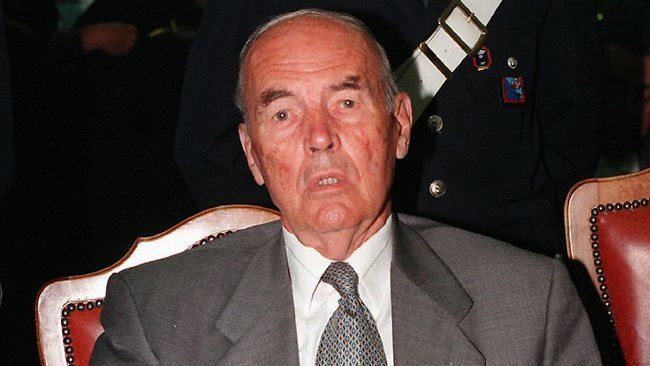
Priebke was born at Hennigsdorf which was then in the Kingdom of Prussia. Little is known of his early life but Priebke told interviewers that his parents died when he was young and that he was reared mainly by an uncle before earning a living as a waiter in Berlin, The Savoy Hotel, London and on the Italian Riviera. From 1936 he worked for the Gestapo as an interpreter and because of his knowledge of Italian he was based in Rome from 1941.

Priebke married Alicia Stoll; the couple had two sons: Jorge, born in 1940 and Ingo, born in 1942.
Fosse Ardeatine massacre
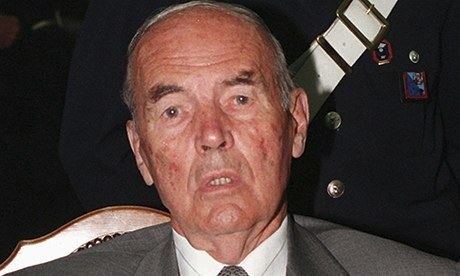
The massacre of Fosse Ardeatine took place in Italy during World War II. On 23 March 1944, 33 German personnel of the SS Police Regiment Bozen were killed when the Italian Resistance set off a bomb, and attacked the SS men with firearms and grenades while they were marching along Via Rasella, in Rome. This attack was led by the Patriotic Action Groups or Gruppi di Azione Patriottica (GAP).
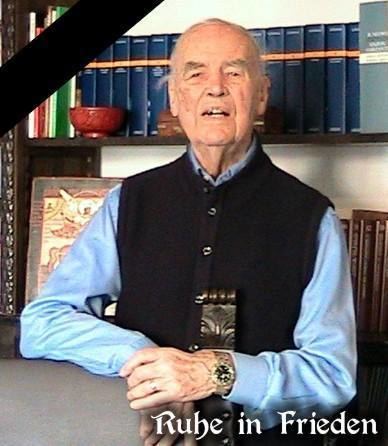
Adolf Hitler is reported, but never confirmed, to have ordered that within 24 hours, ten condemned Italians were to be shot for each dead German. Commander Herbert Kappler in Rome quickly compiled a list of 320 prisoners to be killed. Kappler voluntarily added ten more names to the list when the 33rd German died after the partisan attack. The total number of people executed at the Fosse Ardeatine was 335, mostly Italian. The largest cohesive group among those executed were the members of Bandiera Rossa (Red Flag), a non-mainstream communist (Trotskyist) military resistance group, along with more than 70 Jews.
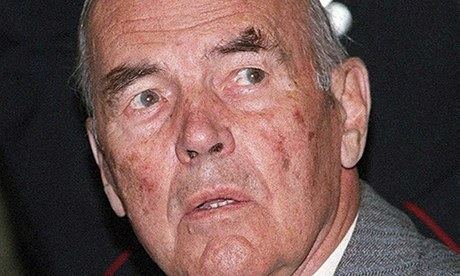
On 24 March, led by SS officers Priebke and Karl Hass, the victims were killed inside the Ardeatine caves in groups of five. They were led into the caves with their hands tied behind their backs and then shot in the neck. Many were forced to kneel down over the bodies of those who had already been killed. During the killings, it was found that a mistake had been made and that five additional people who were not on the list had been brought up to the caves.
There were arguments among the Nazi leadership in Rome and between Hitler and his command over whether 50, 30, or 10 Italians should be killed for every German. Priebke is often accused of murder, because an additional five people were killed who were not on the list of 330 condemned by the "ten to one" rule. As a result, Priebke's trial strongly focused on these extra killings. Priebke was responsible for the list and his complicity in those killings ruled out any possible justification for his behaviour on the basis of "obedience to official orders".
To fill the numerical quota, many of the prisoners at via Tasso and Regina Coeli prison who happened to be available at the time were sent to their deaths by the Nazis at the Fosse Ardeatine. Priebke put some on the list simply because they were Jewish (sending Jews to the camps, however, he said he had never done, for practical reasons: "We needed the railway cars for other things").
Some of these prisoners had simply been residents of via Rasella who were home at the time of the bombing; others had been arrested and tortured for resistance and communist-related activities. Not all of the partisans who were killed were members of the same Resistance group. Members of the GAP, the PA, and Bandiera Rossa, in addition to the Clandestine Military Front, were all on the list of those to be executed. Furthermore, the scale and even the occurrence of this retaliation was unprecedented. Since the Allied invasion of Italy in 1943 and the subsequent overthrow of Mussolini, Communist anti-Fascists and members of the Italian Resistance had been practicing guerrilla warfare against Axis troops.
Postwar escape
In post–World War II trials, Priebke was set to be tried for his role in the massacre, but he managed to escape from a British prison camp in northeastern Italy in 1946. After he had escaped, he lived with a family in Sterzing/Vipiteno. During this time he received on 13 September 1948 a second baptism by a local priest. After his time in South Tyrol he went to Vatican City in Rome to find protection. Bishop Alois Hudal, a main participant in the Vatican's Ratlines, was accustomed to making false travel documents for German officials who had been involved in war crimes, and he supplied Priebke with a falsified visa to travel to Argentina (then led by Juan Perón). Though alleged to have been responsible for war crimes, Priebke lived in Argentina as a free man for 50 years.
In March 1994 an investigative team from ABC News, led by producer Harry Phillips, tracked Priebke to San Carlos de Bariloche after finding mention of his participation in the Rome Massacre in a locally-written book they found in a used-book store. The book, El pintor de la Suiza argentina, by Esteban Buch cited Priebke as part of a story of Nazis living in Bariloche since the early 1950s.
Over the next several weeks the ABC News team searched archives in Buenos Aires, Washington, D.C., London, Berlin and Jerusalem, uncovering numerous documents chronicling Priebke's background and involvement with the notorious Nazi Gestapo in Italy. Among documents discovered in the Public Records Office in London was a confession, written a few months after the end of World War II, in which Priebke confirmed his role in the Ardeatine Caves Massacre. A document uncovered at Yad Vashem Museum in Israel indicated that Priebke signed off on the transport of Italian Jews to death camps. As their research continued, the ABC team began surveillance of Priebke monitoring his daily routine in Bariloche. In April 1994, ABC News reporter Sam Donaldson traveled to Bariloche with Phillips and camera crews to confront Priebke with their research in behalf of the ABC Television news magazine Primetime Live. Donaldson and his team first confronted another former Nazi living in the same town, Reinhard Kopps, who, when pressed about his own involvement, took Donaldson aside and told him about Priebke, confirming the ABC research.
Donaldson and his team waited for Priebke outside the school he was working and interviewed him at his car. After initial hesitation, Priebke admitted who he was and spoke openly about his role in the massacre. He justified his actions by saying that he only followed orders from the Gestapo chief of Rome, Obersturmbannführer Herbert Kappler and that, in his view, the victim were terrorists. He denied to Donaldson any children were killed but 3 children as young as 14 were found among the dead including a 75-year-old man and a priest. He admitted that it was he who compiled the lists of those who were going to be executed. When testifying after the war, Kappler explained that Priebke had been ordered to make sure that all the victims were brought to the caves and executed, and to check the list of people who were to be killed.
Extradition of Priebke
Donaldson's news report showed how openly Priebke could live in Argentina, and how little remorse he felt for his actions. Argentine authorities arrested Priebke. Because of his old age and poor health, he was at first not imprisoned, but rather held under house arrest at his home in Bariloche, where he had lived since 1949.
The extradition of Priebke had several delays - his lawyers used tactics like demanding all Italian documents be translated into Spanish, a process which could have taken two years. The Argentine court eventually denied the process, but appeals and other delays caused the extradition case to take more than a year. His lawyers argued that the case could no longer be criminally prosecuted because the crime of murder was subject to a statute of limitations of 15 years under Argentine law.
In March 1995, after nine months of delays, the president of the Jewish organization B'nai B'rith was promised by, among others, the Argentine president Carlos Menem, that the case would soon be closed, and that Priebke was to be transferred to Italy by the end of the month. In spite of these promises, the Supreme Court of Argentina decided that the case was to be transferred to the local court in Bariloche where the case was originally brought up. This opened the possibility for years of delays from future appeals, while Priebke could live at his home.
In May 1995, an Argentine federal judge accepted the Italian demand for extradition on the grounds that cases of crimes against humanity could not expire. But there were more appeals and rumors that the court might change the ruling.
In August of the same year, it was judged that Priebke was not to be extradited because the case had expired. To put pressure on the Argentine government, Germany demanded extradition the same day. The Italian military prosecutor, Antonio Intelisano, argued that FN agreements to which Argentina was signatory expressly state that cases of war criminals and crimes against humanity do not expire.
After seventeen months of delays, the Argentine supreme court decided that Priebke was to be extradited to Italy. He was put on a direct flight from Bariloche to Ciampino, a military airport close to the Ardeatine caves, where the executions had been carried out many years earlier.
Priebke in court
In court, Priebke declared himself not guilty. He did not deny what he had done, but he denied any moral responsibility. He blamed the massacre on those whom he branded as "the Italian terrorists" who were behind the attack in which 33 German SS men were killed. The order came directly from Hitler, and he thought it was a legitimate punishment. During the trial it became clear that Priebke had personally shot two Italians. This was also in his testimony from 1946 before he managed to escape.
Around noon on 24 March 1944, 335 men went to the Ardeatine Caves in Rome. All were tied with their hands behind their backs, and their names were read out loud. In groups of five, they went into the caves. Priebke went inside together with the second or third group and shot a man with an Italian machine pistol. Toward the end, he shot another man with the same machine pistol. The executions ended when it got dark that night. After the shootings, explosives were used to shut the caves. Priebke was found not guilty for the reason of acting under orders.
On 1 August 1996, orders were given for the immediate release of Priebke. The Italian minister of justice later said that Priebke might be re-arrested, depending on whether or not he would be extradited to Germany to be charged with murder. The courts were blocked by demonstrators for over seven hours after Priebke's trial.
The judges voted two against one for convicting the 83-year-old Priebke for taking part of the massacres, which he had admitted, but he was acquitted again, purportedly because he had been following orders. There were strong reactions from family members of the victims, who claimed the judges put no value on human lives. Shimon Samuels, the leader of the Simon Wiesenthal Center said that with this ruling, Italy was permitting crimes against humanity.
Appeal
The case was appealed by the prosecutors. The day after, Germany asked Italy to keep Priebke imprisoned until their demand to have him extradited was processed, as they wanted him put on trial for the murders of two people that he had personally shot. Outside the courthouse there were demonstrations, but when it became known that Priebke had been rearrested, these protests were calmed. Many people later went to visit the Ardeatine Caves to honour the victims.
The Italian supreme court decided that the court that had freed Priebke was incompetent and the appeal went through. Among other things it was questioned why the Nuremberg trials were not taken up earlier because it had been concluded that an individual has personal responsibility for his actions. The reason that Priebke had been released was that he followed orders. Priebke claimed that if he had not obeyed, he would have been executed, but the appeals would not accept this as they felt it was a baseless excuse.
Goebbels, the Nazi Minister of Propaganda, reiterated the essence of Article 47 and refuted the "I was only following orders" defense in a 28 May 1944 article in the German newspaper Deutsche Allgemeine. There is precedent within the Prusso-German military tradition for disobedience to orders. The oath is not an excuse which the soldier can use to justify immoral acts after the fact as it was used by numerous former German military officers during the various war crime trials that followed World War II or by the defendants in the My Lai massacre trial in 1971.
The Court of Cassation voided the decision, ordering a new trial for Priebke. He was sentenced to 15 years. These were reduced to 10 years because of his age and alleged ill health. In March 1998, the Court of Appeal condemned him to life imprisonment, together with Karl Hass, another former SS member. The decision was upheld in November of the same year by the Court of Cassation. Because of his age, Priebke was put under house arrest. In March 1997, it was decided that Priebke could not be extradited to Germany. The reason for this was that he was now going through a trial which was for the same things that Germany wanted him tried. He could not be tried for the same crime twice.
Priebke's appeals
Priebke denied any responsibility, and therefore appealed the case. At the appeals it was decided that Hass and Priebke had committed murder in the first degree and that they should be given life imprisonment.
Priebke claimed he was blamed for all atrocities done during World War II. "I gave Argentina 50 years of my life, and they don't want me. I fought for Germany during the war, now they want me put to trial for obeying orders."
Priebke appealed the case to the European Court of Human Rights in Strasbourg, where he claimed he had no choice but to obey Hitler's orders, a defense not accepted during the Nuremberg Trials (see Nuremberg Defense and Nuremberg Principle IV). Moreover, it has been underlined by many that in the massacre of the Fosse Ardeatine 335 died, five more than required by the order "10 Italians executed for each German killed". These five extra victims were the responsibility of Priebke alone because he was given the duty of checking the list.
On 20 March 2004, 80 people gathered in a room of the Centro Letterario in Trieste to show their support for Priebke. On 12 June 2007, he received authorization to leave his home for working reasons to work at his lawyer's office in Rome. This led to angry protests and the judge's decision was overturned.
Death
Priebke died in Rome on 11 October 2013 at the age of 100, from natural causes. His last request, that his remains be returned to Argentina so he could be buried alongside his wife, was denied by the Argentinian government. The Vatican issued an "unprecedented ban" on holding his funeral in any Catholic church in Rome. His hometown in Germany also refused to take his body, over fears that his place of burial could become "a pilgrimage site for neo-Nazis."
The Society of Saint Pius X, a canonically irregular Catholic group, offered to hold the funeral ceremony for Erich Priebke in the city of Albano Laziale. Don Florian Abrahamowicz, an ex-SSPX priest of Jewish origin, told Italy's Radio 24: "Priebke was a friend of mine, a Christian, a faithful soldier."
During the funeral service, violent clashes broke out between fascist sympathizers and anti-fascist protesters. The SSPX's funeral ceremony for Erich Priebke eventually took place, albeit without the presence of any of his relatives, because his family was unable to enter the city where it was held due to the rioting.
Eventually, the coffin containing Priebke's body was seized by the Italian authorities and taken to a military base near Rome and then buried "in a secret location," as his lawyer Paolo Giachini stated. "The agreement satisfies the family and ethical and spiritual requirements," he added.
